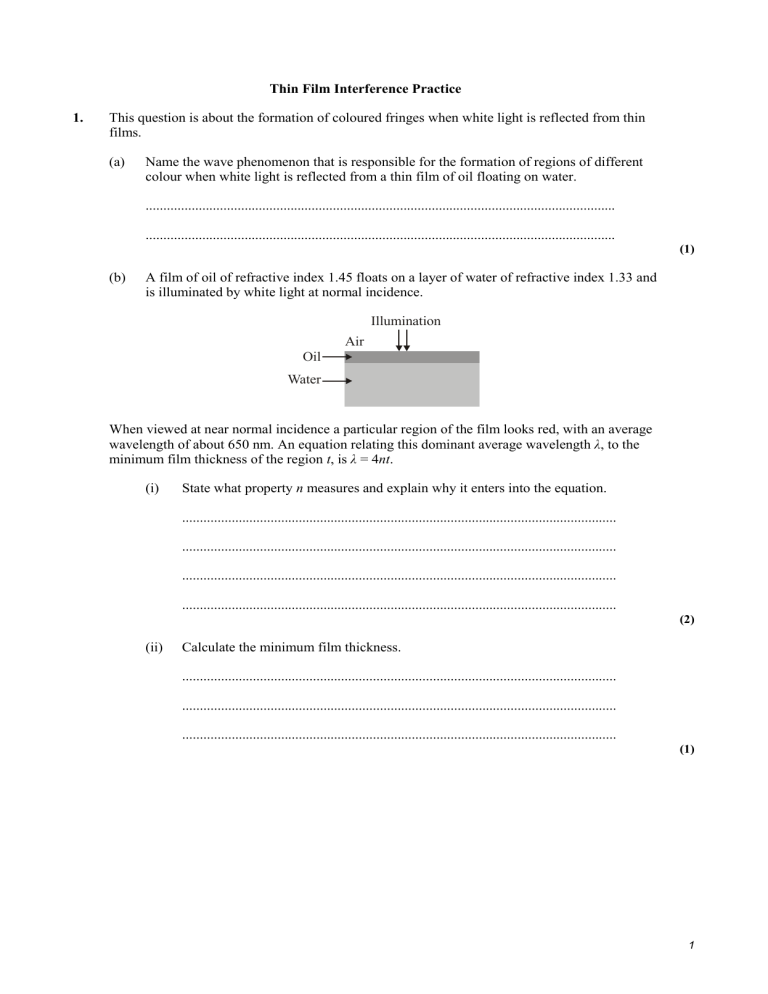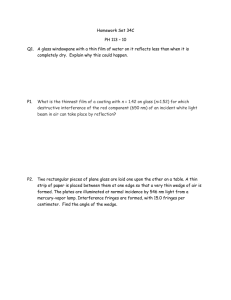Thin Film Interference Practice
advertisement

Thin Film Interference Practice 1. This question is about the formation of coloured fringes when white light is reflected from thin films. (a) Name the wave phenomenon that is responsible for the formation of regions of different colour when white light is reflected from a thin film of oil floating on water. ..................................................................................................................................... ..................................................................................................................................... (1) (b) A film of oil of refractive index 1.45 floats on a layer of water of refractive index 1.33 and is illuminated by white light at normal incidence. Illumination Air Oil Water When viewed at near normal incidence a particular region of the film looks red, with an average wavelength of about 650 nm. An equation relating this dominant average wavelength λ, to the minimum film thickness of the region t, is λ = 4nt. (i) State what property n measures and explain why it enters into the equation. ........................................................................................................................... ........................................................................................................................... ........................................................................................................................... ........................................................................................................................... (2) (ii) Calculate the minimum film thickness. ........................................................................................................................... ........................................................................................................................... ........................................................................................................................... (1) 1 (iii) Describe the change to the conditions for reflection that would result if the oil film was spread over a flat sheet of glass of refractive index 1.76, rather than floating on water. ........................................................................................................................... ........................................................................................................................... ........................................................................................................................... ........................................................................................................................... (2) (Total 6 marks) 2. This question is about thin film interference. Two flat glass plates are in contact along one edge and are separated by a piece of thin metal foil placed parallel to the edge, as shown below. light of wavelength 5.89 x 10 –7 m metal foil glass plate line of contact Diagram not drawn to scale Air is trapped between the two plates. The gap between the two plates is viewed normally using reflected light of wavelength 5.89 × 10–7 m. A series of straight fringes, parallel to the line of contact of the plates is seen. (a) State what can be deduced from the fact that the fringes are straight and parallel. ..................................................................................................................................... (1) (b) Explain why a dark fringe is observed along the line of contact of the glass plates. ..................................................................................................................................... ..................................................................................................................................... ..................................................................................................................................... ..................................................................................................................................... (3) 2 (c) The distance between the line of contact of the plates and the edge of the metal foil is 9.0 cm. The dark fringes are each separated by a distance of 1.4 mm. Calculate the thickness of the metal foil. ..................................................................................................................................... ..................................................................................................................................... ..................................................................................................................................... ..................................................................................................................................... (3) The lenses used in astronomical telescopes are frequently “bloomed”. This means that a thin film is deposited on the lens in order to reduce the intensity of unwanted light reflected by the lens. Destructive interference occurs between the light reflected from the upper and the lower surfaces of the film. The reflections at both surfaces for one incident ray are shown in the diagram. air film glass (d) (i) State why complete destructive interference of all the reflected light does not occur. ........................................................................................................................... ........................................................................................................................... (1) (ii) With reference to your answer in (i), suggest why the film appears to be coloured. ........................................................................................................................... ........................................................................................................................... ........................................................................................................................... (2) (Total 10 marks) 3

